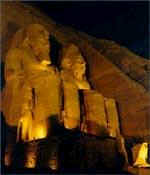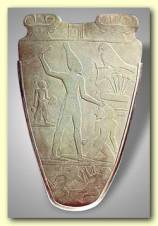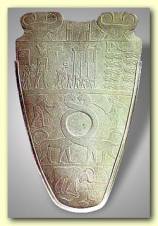|
King Narmer
(Menes) |
|
The first king of the two lands wearing the White Crown of Upper Egypt |
| |
Egyptology Articles
Herbs and Aroma
Alternative
Medicine
Aroma Therapy
|
Egypt was divided into two kingdoms, Upper and Lower Egypt, or the two lands. The first was founded in Lower Egypt, with Botu as its capital, the Papyrus as its sign, and the snake as its symbol. The Southern Kingdom had Nekhen as its capital, and the Lotus as its sign. King Narmer was the first to unite Upper and Lower Egypt
giving birth to Egypt in 3100 B. c & laying the foundation for the first pharaonic dynasty ,which is the beginning of the first Egyptian Dynasty 0. King
Narmar was the first king of the two lands wearing the White Crown of Upper Egypt (looks like a bowling pin), and the Red Crown of Lower Egypt. . His rule marked the beginning of written history and the era of dynasties, which followed in succession until the 30th Dynasty. The Egyptian Dynasty ended with the suicide of Cleopatra, and the Roman army under Octavian taking Egypt in 30 BC.
The Old Kingdom (2980 BC-2475 BC):
During this era, principles of central government were established. Menes (Narmar) was called "the King of Both Lands and Bearer of Both Crowns". The unification of both kingdoms had a significant impact on the development of Egypt in all aspects of life. Hieroglyphic writing was devised.
|
 |
Kings were actively involved in securing the country's borders. Trade between Egypt and Sudan was developed. Egypt, then embarked on a glorious period of its history, known as the pyramid builder's age, where the first pyramid of Saqqara was built.
With the flourishing of agriculture, industry and trade, the first river fleet was introduced by the Egyptians.
With the unification of Upper& Lower Egypt, it was necessary to establish
a strong army whose headquarter was the city of Menf. Narmar also established the Egyptian first fleet in With the beginning of the third
Pharaonic Dynasty in 2686 B.C, Egypt was exposed to manyraids by
the nomads on its eastern borders, the thing that urged king Zosar
to establish army with its own military traditions and its distinct banners.
This army was regarded as the first regular army in history, Later on,
" Zosar " organized Egypt into districts where he set, companies. Moreover,
he established his own royal army made up of corps, and established a substantial fleet as well.
Narmer Palette:
| King Narmer is thought to have reigned c. 3150 BCE as first king of the 1st dynasty (and/or last king of the 0 dynasty) of a unified ancient Egypt. The rebus of his name as shown on his palette and on other inscriptions is composed of a chisel, thought to be read
mr, above a catfish, thought to be read as n'r. King Narmer, or Catfish as he could also be called, appears thus on seal impressions from the 1st Dynasty tombs of King Den (tomb) and King Ka (Tomb) at Abydos . Narmer's name and that of his possible predecessor Scorpion have also been found on pottery vessels from the site of Minshat Abu Omar in the eastern Delta.
|
 |
 |
|
Narmer Palette:
|
Narmer's importance as the probable unifier of Lower and Upper Egypt is indicated primarily by the Palette and the Macehead which are attributed to him. His name-rebus appear on both. But his power in the region must have extended further, since Egyptian sherds inscribed with Narmer's name have also been found .
The Narmer Palette was discovered by J.E.Quibell at Hierakonpolis in 1897-98. The obverse is divided into three registers, uppermost of which gives his name in a serekh flanked by human-faced bovines. The second register shows Narmer wearing the White Crown of Upper Egypt smiting an enemy. The third register shows dead, nude enemies. On the reverse the upper register showing his name-serekh is repeated. The second register shows Narmer now wearing the Red Crown of Lower Egypt, inspecting rows of nude, decapitated enemies. The third register shows a man mastering serpent-necked lions, and the fourth register shows a bull destroying a town and trampling a dead enemy.
Narmer may have considered Buto as the central capital of the Delta he had just conquered. On his palette is a hieroglyphic group that could be read as Ta Mehu, the later name for the Delta region. Since Narmer is shown with the Red Crown he was thus the first to ascribe this Crown to the entire Delta and thus Lower Egypt. He may have transferred the Red Crown from Nubt/Naqada to represent the entirety of Lower Egypt.
The Narmer macehead, also discovered at Hierakonpolis, has had three interpretations. Petrie's theory, also held by later scholars, was that the mace head depicted the political marriage of Nithotep, princess of the north, with Narmer. Other scholars feel the macehead depicts a celebration by Narmer of his conquest of the north, while still others regard the macehead as commemorating a Sed-festival of the king. Nithotep's grave has been found at Naqada, with Narmer's name as well as with King Aha's name. Nithotep thus is linked with two kings as wife and mother.
Namer Macehead:
Most recently, new studies of the images on the macehead put forth the theory that the scenes are not primarily commemorative but are simply pictorial versions of year-names. The focus of the scene is the king's figure, seen sitting robed in a long cloak enthroned under a canopy on a high dais, wearing the Red Crown and holding a flail. The enclosure within which he sits can be interpreted as a shrine or temple. He is attended by minor figures of fan-bearers, bodyguards, with long quarterslaves and an official who may be either vizier or heir-apparent. In front of Narmer three men run a race towards him, while above them stands four men carrying standards. Facing the king is a cloaked and beardless figure, over whom is a simple enclosure in which stands a cow and calf .
The running figures may represent Muu dancers, long associated with Buto, presenting a welcome to the new lord of the Delta. The seated figure facing Narmer may be the chief of Buto rather than a princess of the Delta.
Beneath these figures are symbols of numbers. The numbers have been recently interpreted to indicate 400,000 cattle, 1,422,000 small animals, and 120,000 men (not women and children, only males.) This would have provided for a total human population of the Delta of perhaps 600,000.
The macehead then commemorates the completion of the conquest of Lower Egypt, not with a royal dynastic marriage etc, but perhaps, with the first Appearance of the King of Lower Egypt, by an actual census of the Delta people, similar to and a precursor of the census taken by William the Conqueror after he won England.
Some scholars speculate that Menes and Narmer may be the same person. Menes is the Greek form of the name of the legendary first human king of Egypt as given by Manetho, the historian living in Hellenistic times who constructed one form of King Lists.
Hor-Aha, the first king of the First Dynasty and thus Narmer's probable successor and possibly his son by Queen Nithotep, perhaps took the second royal name of Men, which means "established", thus being the origin of the name Menes.
Evidence indicating all this is an ivory label from the tomb of Queen Nithotep at Naqada. It shows the name Hor-Aha, and the name Men, in front of it.
|
You may freely reprint this article
or place it on your website by
adding this statement: Courtesy of www.kingtutshop.com
|
_________________________________



